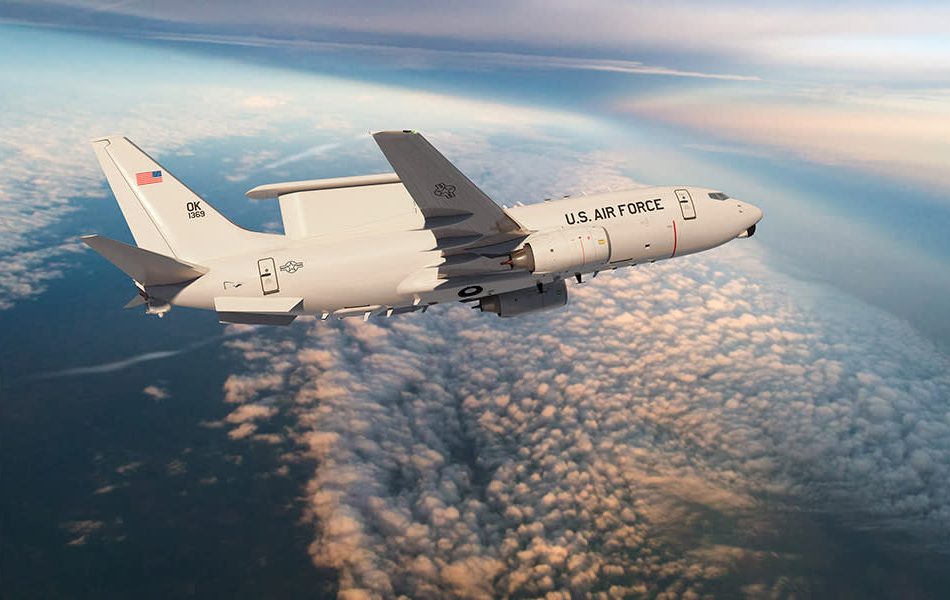Why the Air Force Is Paying Boeing $2.6 Billion for Just 2 Airplanes
Boeing (NYSE: BA) might end up selling its defense unit — but it’s not out of the defense business yet. In a huge announcement that might give a clue to the company’s future, the U.S. Air Force (USAF) confirmed last week that it has awarded Boeing $2.56 billion to build for it “two operationally representative prototype E-7A weapons systems.”
The contract was the single biggest award listed on the Department of Defense’s daily contracts update Aug. 9 — by a factor of four. (Second place went to a Lockheed Martin contract for Navy radar systems worth $611 million.) Even more important than the dollar value is the fact that Boeing’s contract has a lot of room to grow.
What the Air Force is buying from Boeing
Boeing’s E-7A Wedgetail aircraft is designed for Airborne Early Warning and Control (AEW&C) of moving targets. The most famous example of this technology is the Air Force’s E-3 Sentry AWACS (an acronym of “Airborne Warning and Control System”), which was first introduced in 1977, and which the Air Force intends to gradually upgrade and replace.
Boeing is already producing an E-7 Wedgetail (introduced in 2012, and based on the airplane maker’s 737 Next Generation airliner), primarily for foreign militaries. The E-7A will be an upgrade of that platform, and the Air Force wants Boeing to expedite its development by producing a couple of “rapid prototypes” — hence the supersize contract.
Early editions of any new weapons system tend to cost more than once the system has reached scaled production. But the price on this contract still seems quite high. For context, a 2012 contract to build four plain vanilla E-7 Wedgetails for South Korea cost that country only $1.7 billion — barely $400 million per plane. In contrast, the Air Force will paying roughly 3 times as much for each of its first two E-7As.
The urgency of the Air Force’s request for rapid prototypes — needed to make a production decision in 2026 — probably helps to explain why it’s willing to pay so much more for these aircraft. But even so, “rapid” seems a rather flexible term. According to the Air Force itself, Boeing isn’t expected to deliver the prototype E-7As before 2028 — two years after the production decision will be made!
What it means for Boeing
A lot is riding on how that decision goes for Boeing (and for Northrop Grumman (NYSE: NOC), too, which builds the E-7A’s radar). Beyond the first two aircraft, the Air Force aims to buy two dozen more Wedgetails — 26 in all. And beyond just USAF, Breaking Defense notes global demand for the E-7A could grow the program perhaps 2 to 3 times in size. Ultimately, Boeing could end up selling 50 to 70 units of this new AWACS, and building as many as six planes per year once production is fully ramped up.
How much money that ultimately means for Boeing remains to be seen. Breaking Defense quoted Air Force acquisition head Andrew Hunter commending Boeing’s willingness to “get their pencils out and sharpen them and do a good job to bring the cost of the rapid prototyping program down” — albeit not quite down to the level the Koreans paid 12 years ago.
Until we know the final price, though, all we’ve really got to work with is the prototype price: $1.3 billion per bird. So what might that be worth to Boeing?
Well, with the strong caveat that this is probably a ceiling value on what the contract could be worth, $1.3 billion per plane, times a maximum of 70 Wedgetails total, implies a total program value of $91 billion for Boeing. Investors should of course temper that expectation with the realization that prices will come down as production scales up — and with the understanding that if Boeing is only building at most six planes per year, then this $91 billion would be spread out over more than a decade of production.
Even so, the final number could still end up looking very attractive, on the order of perhaps $8 billion or $9 billion a year, or roughly one-third of the revenue Boeing’s defense unit produces today, according to data from S&P Global Market Intelligence. And that doesn’t even count the ongoing revenue Boeing can expect to accrue from servicing, maintaining, and upgrading the planes over years to come. Recall that the E-3 Sentries the Wedgetail is replacing have been flying for nearly 50 years now.
All things considered, this seems to be pretty great news for Boeing. With contracts like this one, maybe Boeing should consider hanging onto its defense business after all.
Should you invest $1,000 in Boeing right now?
Before you buy stock in Boeing, consider this:
The Motley Fool Stock Advisor analyst team just identified what they believe are the 10 best stocks for investors to buy now… and Boeing wasn’t one of them. The 10 stocks that made the cut could produce monster returns in the coming years.
Consider when Nvidia made this list on April 15, 2005… if you invested $1,000 at the time of our recommendation, you’d have $792,725!*
Stock Advisor provides investors with an easy-to-follow blueprint for success, including guidance on building a portfolio, regular updates from analysts, and two new stock picks each month. The Stock Advisor service has more than quadrupled the return of S&P 500 since 2002*.
*Stock Advisor returns as of August 22, 2024
Rich Smith has no position in any of the stocks mentioned. The Motley Fool recommends Lockheed Martin. The Motley Fool has a disclosure policy.
Why the Air Force Is Paying Boeing $2.6 Billion for Just 2 Airplanes was originally published by The Motley Fool





Leave a Reply